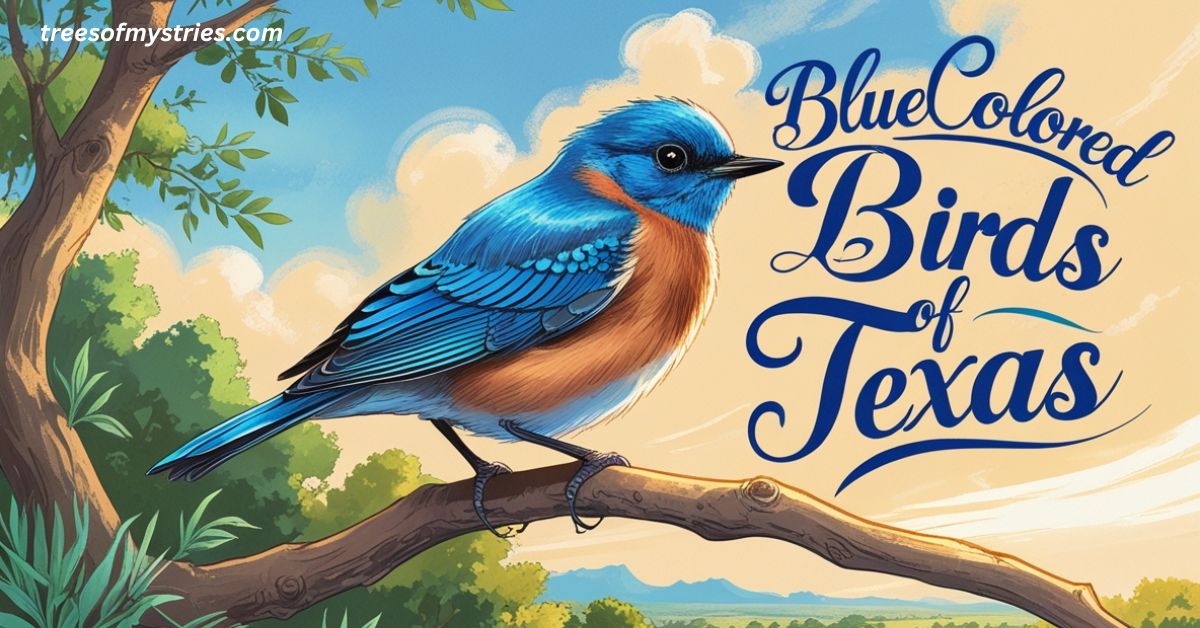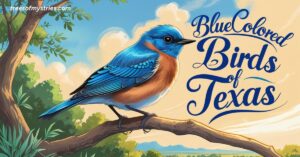Texas is a haven for bird enthusiasts, and its skies are adorned with some of the most stunning blue-colored birds. From the vibrant Indigo Bunting to the majestic Black-throated Magpie-Jay, these birds add a splash of color to the state’s diverse landscapes. Identifying these 18 blue colored birds is not only a treat for the eyes but also a way to connect with nature.
The term “18 Blue Colored Birds of Texas Identification” refers to a guide that helps birdwatchers recognize and learn about the unique blue-hued avian species found in Texas. This guide provides detailed descriptions of their colors, habitats, nesting habits, and more. It’s a valuable resource for anyone eager to explore Texas’s rich birdlife and appreciate its natural beauty.
In this article, you’ll discover fascinating details about each of these 18 blue birds, including their sizes, weights, and wingspans. You’ll also learn where to spot them and how to attract them to your garden. Whether you’re a seasoned birder or a curious beginner, this guide will deepen your appreciation for Texas’s winged wonders and inspire you to protect their habitats.
Popular Blue Colored Birds of Texas full List :
Here’s a listing 18 bird names along with their color descriptions:
| Bird Name | Color Description |
| 1. Steller’s Jay | Deep blue with a black head and upper body. |
| 2. Indigo Bunting | Bright blue overall. |
| 3. Purple Gallinule | Iridescent purple-blue with a green back and yellow legs. |
| 4. Mountain Bluebird | Bright blue with a lighter underbelly. |
| 5. Blue Grosbeak | Deep blue with rusty wingbars. |
| 6. Mexican Jay | Blue-gray with a lighter underbelly. |
| 7. Western Bluebird | Deep blue with a rust-orange chest. |
| 8. Purple Martin | Dark blue-purple overall. |
| 9. Cerulean Warbler | Sky-blue with streaked underparts. |
| 10. Tree Swallow | Iridescent blue-green above and white below. |
| 11. Ringed Kingfisher | Blue-gray with a white collar and rust-orange belt. |
| 12. Blue-gray Gnatcatcher | Blue-gray with a long tail and noticeable eye ring. |
| 13. Lazuli Bunting | Bright blue with white underparts and rust-orange chest. |
| 14. Black-throated Magpie-Jay | Blue with a white belly and long tail feathers. |
| 15. Eastern Bluebird | Bright blue with a rusty throat and chest. |
| 16. Blue Jay | Blue with white and black markings. |
| 17. Painted Bunting | Bright blue head with green back and red underparts. |
| 18. Belted Kingfisher | Blue-gray with a white collar and a blue band on the chest. |
1.Steller’s Jay – (Cyanocitta stelleri):
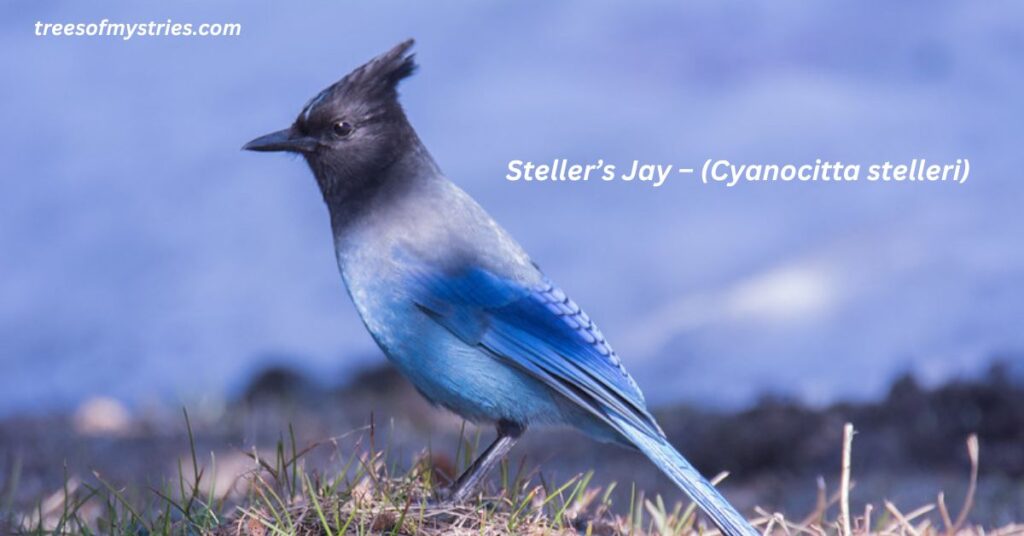
Have you seen the Steller’s Jay? With its bright blue feathers and black cap-like crest, it’s easy to spot! This bird is not just pretty; it’s very smart and can copy other bird sounds. For a home, it picks tall trees and builds nests using twigs and moss.
The Steller’s Jay loves the pine forests of Texas. Here’s a fun fact: it lays 3 to 5 eggs, and both parents feed and protect the babies. This bird enjoys eating nuts, seeds, and insects.
- Color: Deep blue with a black head.
- Habitat: Pine forests.
- Nesting: Tall trees, using twigs and moss.
- Eggs: 3 to 5.
- Diet: Nuts, seeds, and insects.
- Behavior: Mimics other birds and is very clever.
- Length: 12–13 in (30–34 cm).
- Weight: 3.5–4.9 oz (100–140 gm).
- Wingspan: 17–19 in (43–49 cm).
The Steller’s Jay is a special bird that makes Texas forests even more beautiful.
2. Indigo Bunting – (Passerina cyanea):
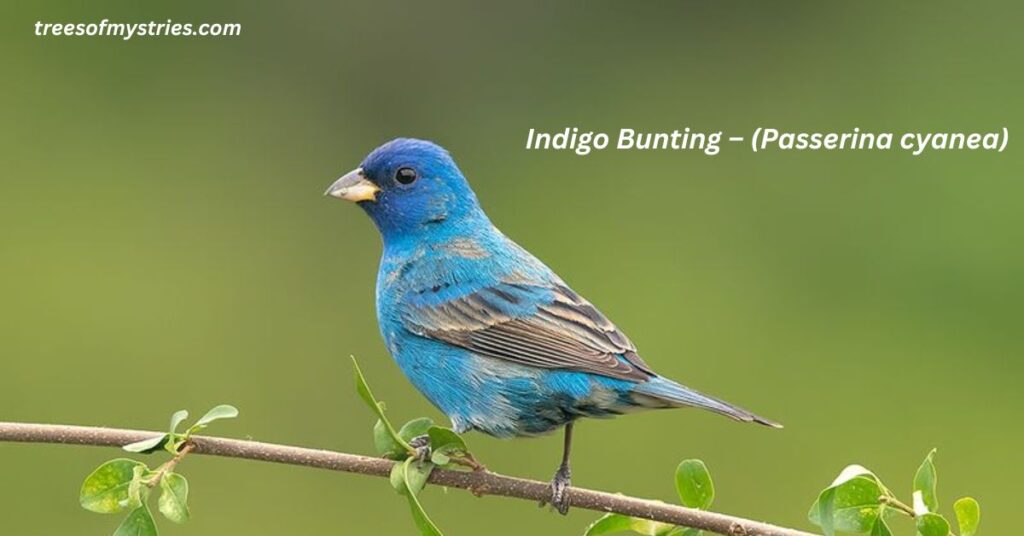
Have you heard of the Indigo Bunting? With its bright blue feathers, it looks like a tiny piece of the sky! This small bird is not just colorful; it travels at night using stars to find its way. For a home, it picks low shrubs and builds nests using grass and twigs.
The Indigo Bunting loves the open woodlands of Texas. Here’s a fun fact: it lays 3 to 4 eggs, and both parents take turns feeding the chicks. This bird enjoys eating seeds and insects.
- Color: Bright blue overall.
- Habitat: Open woodlands and brushy areas.
- Nesting: Low shrubs, using grass and twigs.
- Eggs: 3 to 4.
- Diet: Seeds and insects.
- Behavior: Travels at night using stars.
- Length: 4.7–5.1 in (12–13 cm).
- Weight: 0.4–0.6 oz (12–18 gm).
- Wingspan: 7.5–8.7 in (19–22 cm).
The Indigo Bunting is a small but stunning bird that adds beauty to Texas skies.
3. Purple Gallinule – (Porphyrio martinicus):

The Purple Gallinule is a stunning bird with iridescent purple-blue feathers and yellow legs. Its bright colors make it stand out in the marshes. This bird walks gracefully on floating plants and builds nests in wet areas using reeds and grasses.
Found in the marshes and wetlands of Texas, the Purple Gallinule lays up to 7 eggs. Both parents take care of the eggs and feed the chicks. It enjoys a diet of plants, insects, and small fish.
- Color: Iridescent purple-blue with a green back and yellow legs.
- Habitat: Marshes and wetlands.
- Nesting: Wet areas, using reeds and grasses.
- Eggs: Up to 7.
- Diet: Plants, insects, and small fish.
- Behavior: Walks on floating vegetation.
- Length: 10–15 in (26–37 cm).
- Weight: 5.0–10.8 oz (141–305 gm).
- Wingspan: 10–15 in (26–37 cm).
The Purple Gallinule is a vibrant bird that adds beauty to Texas wetlands.
4. Mountain Bluebird – (Sialia currucoides):
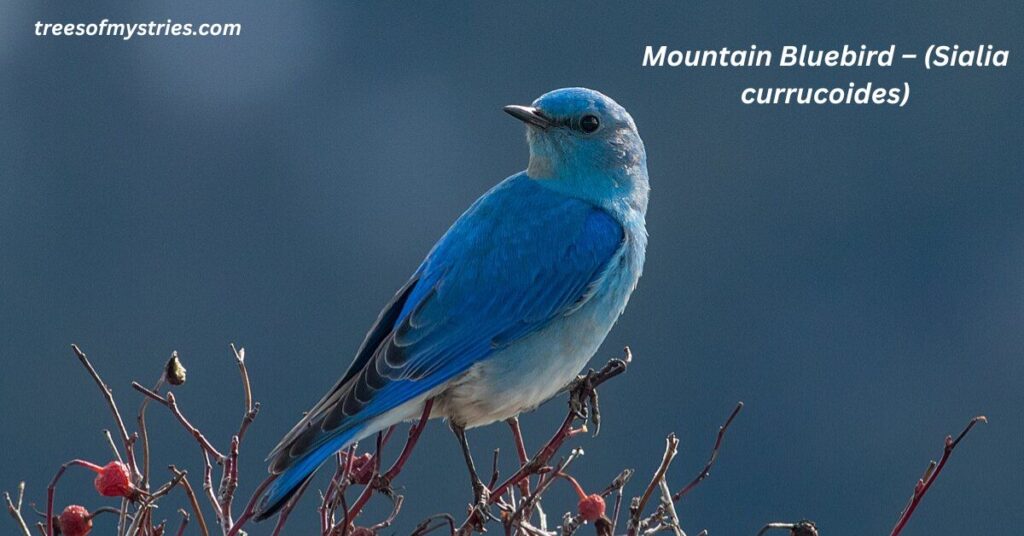
The Mountain Bluebird is a beautiful bird with bright blue feathers and a lighter underbelly. Its striking colors make it easy to spot in open areas. This bird prefers nesting in tree cavities or nest boxes, creating cozy homes for its young.
Living in the open fields and meadows of Texas, the Mountain Bluebird lays 4 to 6 eggs. Both parents work together to feed and protect the chicks. It enjoys eating insects and berries, making it helpful to the environment.
- Color: Bright blue with a lighter underbelly.
- Habitat: Open fields and meadows.
- Nesting: Tree cavities or nest boxes.
- Eggs: 4 to 6.
- Diet: Insects and berries.
- Behavior: Helps control insect populations.
- Length: 6.3–7.9 in (16–20 cm).
- Weight: 0.85–1.31 oz (24–37 gm).
- Wingspan: 11.0–14.2 in (28–36 cm).
The Mountain Bluebird is a cheerful bird that brightens the landscapes of Texas.
5. Blue Grosbeak – (Passerina caerulea):
The Blue Grosbeak is a striking bird with deep blue feathers and rusty wingbars. Its vibrant colors make it a standout in open woodlands. This bird builds nests in shrubs or trees, using grass and twigs to create a safe space for its young.
Found in the open woodlands and brushy areas of Texas, the Blue Grosbeak lays 3 to 5 eggs. Both parents share the responsibility of feeding and caring for the chicks. It enjoys a diet of seeds, insects, and small fruits, making it an important part of the ecosystem.
- Color: Deep blue with rusty wingbars.
- Habitat: Open woodlands and brushy areas.
- Nesting: Shrubs or trees, using grass and twigs.
- Eggs: 3 to 5.
- Diet: Seeds, insects, and small fruits.
- Behavior: Helps control insect populations.
- Length: 5.5–7.5 in (14–19 cm).
- Weight: 0.92–1.11 oz (26–31.5 gm).
- Wingspan: 10–11 in (26–29 cm).
The Blue Grosbeak is a colorful and helpful bird that adds charm to Texas woodlands.
6. Mexican Jay – (Aphelocoma wollweberi):
The Mexican Jay is a blue-gray bird with a lighter underbelly and a playful nature. Its social behavior makes it fun to watch as it often moves in noisy groups. This bird builds nests in oak or pine trees, using twigs to create a sturdy home.
Living in the canyons and forests of Texas, the Mexican Jay lays 4 to 6 eggs. The entire flock helps care for the chicks, showing teamwork. It enjoys eating nuts, seeds, and insects, making it an active part of the forest ecosystem.
- Color: Blue-gray with a lighter underbelly.
- Habitat: Canyons and forests.
- Nesting: Oak or pine trees, using twigs.
- Eggs: 4 to 6.
- Diet: Nuts, seeds, and insects.
- Behavior: Moves in noisy groups and shows teamwork.
- Length: 11–13 in (28–33 cm).
- Weight: 2.3–4.3 oz (65–122 gm).
- Wingspan: 13.4–16.9 in (34–43 cm).
The Mexican Jay is a lively and social bird that brings energy to Texas forests.
7.Western Bluebird – (Sialia mexicana):
The Western Bluebird is a charming bird with deep blue feathers and a rust-orange chest. Its bright colors make it a favorite among birdwatchers. This bird builds nests in tree cavities or birdhouses, creating a safe space for its young.
Found in the open woodlands of Texas, the Western Bluebird lays 4 to 6 eggs. Both parents work together to feed and protect the chicks. It enjoys eating insects and berries, helping to keep the environment balanced.
- Color: Deep blue with a rust-orange chest.
- Habitat: Open woodlands.
- Nesting: Tree cavities or birdhouses.
- Eggs: 4 to 6.
- Diet: Insects and berries.
- Behavior: Helps control insect populations.
- Length: 5.9–7.1 in (15–18 cm).
- Weight: 0.84–1.09 oz (24–31 gm).
- Wingspan: 11.4–13.4 in (29–34 cm).
The Western Bluebird is a cheerful bird that adds beauty to Texas woodlands.
8.Purple Martin – (Progne subis):
The Purple Martin is a sleek bird with dark blue-purple feathers that shine in the sunlight. Known for its aerial acrobatics, this bird loves to swoop and dive in the sky. It builds nests in gourds or multi-compartment birdhouses, creating a safe home for its young.
Found across Texas, the Purple Martin lays 4 to 6 eggs. Both parents take turns feeding the chicks and teaching them to fly. It enjoys eating flying insects, making it a helpful bird for controlling pests.
- Color: Dark blue-purple overall.
- Habitat: Across Texas, often near water.
- Nesting: Gourds or multi-compartment birdhouses.
- Eggs: 4 to 6.
- Diet: Flying insects.
- Behavior: Skilled at aerial acrobatics.
- Length: 7.5–7.9 in (19–20 cm).
- Weight: 1.6–2.1 oz (45–60 gm).
- Wingspan: 15.3–16.1 in (39–41 cm).
The Purple Martin is a graceful bird that adds elegance to Texas skies.
9. Cerulean Warbler – (Setophaga cerulea):
The Cerulean Warbler is a small bird with sky-blue feathers and streaked underparts. Its bright colors make it a delight to spot in the forest. This bird builds nests high in tall trees, using twigs and grass to create a cozy home.
Found in the forests of Texas, the Cerulean Warbler lays 3 to 4 eggs. Both parents work together to feed and care for the chicks. It enjoys eating insects and spiders, helping to keep the forest healthy.
- Color: Sky-blue with streaked underparts.
- Habitat: Forests.
- Nesting: Tall trees, using twigs and grass.
- Eggs: 3 to 4.
- Diet: Insects and spiders.
- Behavior: Moves quickly through trees.
- Length: 4.3 in (11 cm).
- Weight: 0.3 oz (8–10 gm).
- Wingspan: 7.9 in (20 cm).
The Cerulean Warbler is a tiny but vibrant bird that brightens Texas forests.
You’ll Love: Blue Jay Spiritual Meaning: Symbolism and Love Revealed
10. Tree Swallow – (Tachycineta bicolor):
The Tree Swallow is a sleek bird with iridescent blue-green feathers on top and white underparts. Its shiny colors make it stand out in open areas. This bird builds nests in tree cavities or man-made birdhouses, using grass and feathers for comfort.
Found in the open fields and wetlands of Texas, the Tree Swallow lays 4 to 7 eggs. Both parents take turns feeding the chicks and keeping them safe. It enjoys eating flying insects, making it helpful for controlling pests.
- Color: Iridescent blue-green above and white below.
- Habitat: Open fields and wetlands.
- Nesting: Tree cavities or man-made birdhouses.
- Eggs: 4 to 7.
- Diet: Flying insects.
- Behavior: Agile flier, catches insects mid-air.
- Length: 4.7–5.5 in (12–14 cm).
- Weight: 0.60–0.90 oz (17–25.5 gm).
- Wingspan: 11.8–13.8 in (30–35 cm).
The Tree Swallow is a graceful bird that adds charm to Texas skies.
11.Ringed Kingfisher – (Megaceryle torquata):
The Ringed Kingfisher is a striking bird with blue-gray feathers, a white collar, and a rust-orange belt. Its bold colors make it easy to spot near water. This bird builds nests by digging tunnels in riverbanks, creating a safe place for its young.
Found near freshwater habitats in Texas, the Ringed Kingfisher lays 3 to 5 eggs. Both parents take turns feeding the chicks and teaching them to fish. It enjoys eating fish and small aquatic animals, making it a skilled hunter.
- Color: Blue-gray with a white collar and rust-orange belt.
- Habitat: Freshwater habitats.
- Nesting: Riverbanks, digging tunnels.
- Eggs: 3 to 5.
- Diet: Fish and small aquatic animals.
- Behavior: Skilled at diving to catch prey.
- Length: 14.2–16.1 in (36–41 cm).
- Weight: 10.8–12.0 oz (305–341 gm).
- Wingspan: 18.5–21.1 in (47–53.5 cm).
The Ringed Kingfisher is a powerful bird that adds excitement to Texas waterways.
12. Blue-gray Gnatcatcher – (Polioptila caerulea):
The Blue-gray Gnatcatcher is a tiny bird with soft blue-gray feathers and a long tail. Its quick movements and twitching tail make it fun to watch. This bird builds cup-shaped nests high in trees, using lichens and spiderwebs for a cozy home.
Found in the woodlands of Texas, the Blue-gray Gnatcatcher lays 4 to 5 eggs. Both parents work hard to feed the chicks and protect the nest. It enjoys eating insects and spiders, helping to keep the forest healthy.
- Color: Soft blue-gray with a long tail.
- Habitat: Woodlands.
- Nesting: High in trees, using lichens and spiderwebs.
- Eggs: 4 to 5.
- Diet: Insects and spiders.
- Behavior: Moves quickly and twitches its tail.
- Length: 3.9–5.1 in (10–13 cm).
- Weight: 0.18–0.25 oz (5–7 gm).
- Wingspan: 6.3 in (16 cm).
The Blue-gray Gnatcatcher is a lively bird that adds energy to Texas woodlands.
13. Lazuli Bunting – (Passerina amoena):
The Lazuli Bunting is a small bird with bright blue feathers on its head and back, a white belly, and a rust-orange chest. Its vibrant colors make it a joy to spot in open areas. This bird builds cup-shaped nests in shrubs, using grass and twigs for a safe home.
Found in the open woods and near streams of Texas, the Lazuli Bunting lays 3 to 4 eggs. Both parents take turns feeding the chicks and keeping them safe. It enjoys eating seeds and insects, making it a helpful part of the ecosystem.
- Color: Bright blue with a white belly and rust-orange chest.
- Habitat: Open woods and near streams.
- Nesting: Shrubs, using grass and twigs.
- Eggs: 3 to 4.
- Diet: Seeds and insects.
- Behavior: Moves quickly and sings sweet songs.
- Length: 5.1–5.9 in (13–15 cm).
- Weight: 0.5–0.6 oz (13–18 gm).
- Wingspan: 8.7 in (22 cm).
The Lazuli Bunting is a colorful bird that brightens the landscapes of Texas.
14. Black-throated Magpie-Jay – (Calocitta colliei):
The Black-throated Magpie-Jay is a stunning bird with blue feathers, a white belly, and long tail feathers. Its bold colors and unique shape make it hard to miss. This bird builds nests on tall trees, using twigs and leaves for a sturdy home.
Found in the northern parts of Texas, the Black-throated Magpie-Jay lays 4 to 6 eggs. Both parents work together to feed and protect the chicks. It enjoys eating insects, fruits, and small animals, making it an active part of the ecosystem.
- Color: Blue with a white belly and long tail feathers.
- Habitat: Northern Texas, often in dry forests.
- Nesting: Tall trees, using twigs and leaves.
- Eggs: 4 to 6.
- Diet: Insects, fruits, and small animals.
- Behavior: Moves in groups and is very social.
- Length: 23.0–30.1 in (58.5–76.5 cm).
- Weight: 7.9–8.9 oz (225–251 gm).
- Wingspan: 20.5–24 in (52–61 cm).
The Black-throated Magpie-Jay is a striking bird that adds beauty and energy to Texas forests.
Conservation Efforts in Texas:
Texas is working hard to protect its blue colored birds and their habitats. Efforts include creating bird-friendly spaces, planting native trees, and setting up nesting boxes. These steps help birds like the Eastern Bluebird and Purple Martin find safe places to live and raise their young. By preserving forests, wetlands, and open areas, Texas ensures these birds have the resources they need to thrive.
Another important effort is raising awareness about the importance of birds in the environment. Programs teach people how to help by keeping areas clean, reducing pollution, and supporting conservation projects. Thanks to these conservation efforts, many bird populations in Texas are growing and thriving. These actions show how teamwork and care can make a big difference for the state’s wildlife.
Threats to the Blue Birds of Texas
The blue-colored birds of Texas face several challenges that threaten their survival. Habitat loss is a major issue, as forests and wetlands are cleared for development. This reduces the spaces where birds like the Indigo Bunting and Mountain Bluebird can live and nest. Pollution and climate change also harm their food sources and nesting areas.
Another threat comes from predators, such as cats and larger birds, which can harm eggs and chicks. Human activities, like using pesticides, also affect their health and food supply. These challenges make it harder for blue birds to thrive in Texas. Protecting their habitats and reducing these threats is essential for their survival.
FAQs :
What makes blue colored birds stand out in Texas?
The vibrant blue feathers of these birds make them easy to spot. Their bright colors add beauty to Texas forests, fields, and wetlands.
Where can you find blue colored birds in Texas?
These birds live in various habitats like pine forests, open woodlands, and marshes. They often nest in trees, shrubs, or near water.
Why are blue colored birds important to the environment?
They help control insect populations and spread seeds. Their presence keeps ecosystems balanced and healthy.
What challenges do blue colored birds face?
Habitat loss and pollution threaten their survival. Predators and climate change also make it harder for them to thrive.
How can people help protect blue colored birds?
Planting native trees and setting up birdhouses can help. Reducing pollution and supporting conservation efforts also make a big difference.
Conclusion: Blue Colored Birds
Blue colored birds are a vital part of Texas’s natural beauty and ecosystem. Their vibrant feathers and unique behaviors make them a joy to watch. These birds play an important role in maintaining balance in nature by controlling insects and spreading seeds.
From the striking Indigo Bunting to the graceful Tree Swallow, each bird adds charm to Texas’s landscapes. However, challenges like habitat loss and pollution threaten their survival. Conservation efforts, such as creating bird-friendly spaces and raising awareness, are helping protect these beautiful creatures.
Blue colored birds inspire us to appreciate and protect the wonders of nature. Their presence reminds us of the importance of preserving wildlife for future generations. Let’s continue to support conservation efforts and explore more about these amazing birds to ensure they thrive in Texas and beyond.
